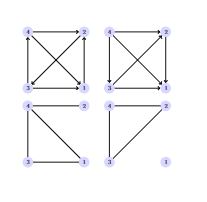(i,j)-step competition graphs
Researchers: Carissa Babcock and Max Black
Mentor: Dr. Kim A.S. Factor
Background
Joel E. Cohen, in 1968, began modeling ecosystems with competition graphs; consequently, mathematicians began developing his new mathematical object. Informally, competition graphs are collections of dots and lines representing some "competitive" relationship between two species, players, companies, etc. Formally, if we let "let D be a directed graph having no multiple edges, the competition graph of D is an undirected graph G on the same node set as D and having an undirected edge {ui, vj} if and only if there exists a third node uk such that {vi, vk} and {vj, uk} are directed edges in the edge set of D "(Dutton et al). Competition graphs, when applied to ecosystems, illuminate previously mysterious properties regarding a community through portraying relationships between species. The relationships they portray help identify primary and secondary extinctions between species, when exploring them.
(1,2)-step competition graphs expand on competition graphs. We know from Dr. Factor and Dr. Merz's paper, The (1,2)-step competition graph of a tournament, that the competition graph of a digraph D is contained in (a subgraph of) the (1,2)-step competition graph on D. Specifically, (1,2)-step competition graphs clearly display direct and indirect relationships between vertices; in the language of ecosystems, they display the direct and indirect relationships (up to length 2) between various species within a community. Our formal definition for these graphs comes from Factor and Merz's paper: "the (1,2)-step competition graph of a digraph D, denoted C1,2(D), is a graph on V(D) where {x,y} in E(C1,2(D)) if and only if there exists a vertex z not equal to x,y, such that either dD-y(x,z) less than or equal to 1 and dD-x(y,z) is less than or equal to 2 [or vice versa]." The (1,2)-step competition graph is generalized by the (i,j)-step graph.
(i,j)-step graphs display relationships between vertices of an arbitrary length. That is, since they generalize (1,2)-step competition graphs, our formal definition comes, again, from Factor and Merz's paper: "the (i,j)-step competition graph of a digraph D, denoted Ci,j(D), is a graph on V(D) where {x,y} in E(Ci,j(D)) if and only if there exists a vertex z not equal to x,y, such that either dD-y(x,z) less than or equal to i and dD-x(y,z) is less than or equal to j [or vice versa]". In the (1,2)-step competition graph, we saw indirect relationships up to 2; with the (i,j)-step competition graph, we can identify indirect relationships up to i and j. For instance, we could let i = 1, preserving direct relationships, and let j be the value of how indirect of relationships we want to observe. Thus, with the (i,j)-step graph, we control the relationships we want to see.
This project has two main goals: expanding the theory for (i,j)-step graphs and exploring their applications. For expanding their theory, this project may explore generalizations, applications to various families of graphs, or explorations with hypergraphs. Concerning their applications, this project may examine and implement various (1,2)-step competition graphs directed towards explaining various relations between species, explaining primary and secondary extinctions, or explaining potential for extinctions within various communities. Throughout the summer, the researchers will take this project in the directions they see fit.
Objectives
During this project, we will examine and explore the following:
- Previous research regarding competition graphs and (1,2)-step competition graphs of food webs
- Competition graphs and (1,2)-step competition graphs of a specific food web
Additionally, we will further previous research by doing the following:
- Furthering research on (i,j)-step competition graphs by exploring new theory and computation
- Applying competition graphs and (i,j)-step competition graphs in new areas
A brief overview of our goals for this 10 week process are listed below. For a complete list of our goals, click here.
| Week | Description | |
| Week 1 (5/30/17-6/2/17): Orientation and Introductions |
| |
|---|---|---|
| Week 2 (6/5/17-6/9/17): Experiment with (1,2)-Step Competition Graphs Using Specific Examples |
| |
| Week 3 (6/12/17-6/16/17): Formulating Research Questions |
| |
| Week 4 (6/19/17-6/23/17): Refine Research |
| |
| Week 5 (6/26/17-6/30/17): Mini Presentations |
| |
| Week 6 (7/3/17-7/7/17): Continue Individual research |
| |
| Week 7 (7/10/17-7/14/17): Resolve Conjectures |
| |
| Week 8 (7/17/17-7/21/17): Begin Finalizing Paper |
|
|
| Week 9 (7/24/17-7/28/17): Posters and Future Research (Dr. Factor Out of Town) |
| |
| Week 10 (7/31/17-8/4/17): Formal Talks, Posters, Papers, and Goodbyes |
|
Research Logs
Each researcher keeps a log of the entire process, including reflections at the end of the week. These logs demonstrate the researcher's actual progress on their respective projects. Specifically, this determines whether or not they are actually reaching their milestones and completing their goals. If you would like to read them, click the researcher's name: Carissa Babcock or Max Black.
